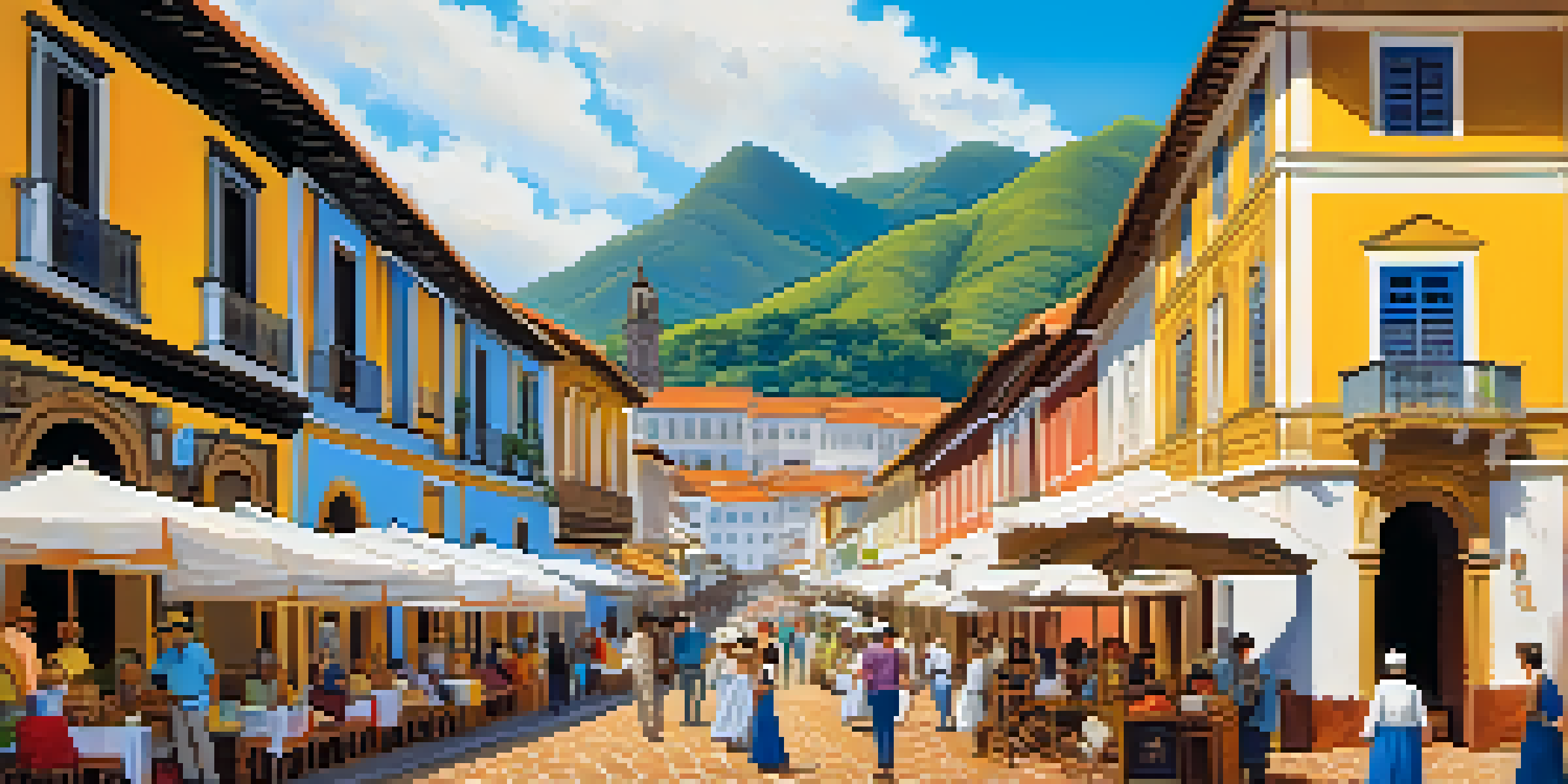Historical Narratives: The Journey of Brazil's Golden Age

Understanding Brazil's Golden Age: An Overview
Brazil's Golden Age refers to a significant period in the 18th and 19th centuries characterized by economic prosperity and cultural flourishing. This era was marked by the discovery of gold and diamonds, which transformed the colony into a hub of wealth and trade. The influx of riches not only boosted the economy but also attracted attention from European powers, enhancing Brazil’s global significance.
History is the version of past events that people have decided to agree upon.
The Golden Age laid the groundwork for Brazil's social and political dynamics, influencing its development long after the wealth began to dwindle. Cities like Ouro Preto and Mariana became symbols of this wealth, showcasing stunning colonial architecture and vibrant cultures. This period also saw the rise of a unique Brazilian identity, blending indigenous, African, and European influences in art, music, and religion.
Ultimately, the Golden Age was not just about wealth; it was a complex tapestry of social change, cultural exchange, and political evolution. Understanding this era helps us appreciate Brazil’s intricate history and provides context for the country’s current cultural landscape.
The Economic Boom: Gold and Diamonds
The discovery of gold in the late 17th century led to an economic boom that would define Brazil's Golden Age. Explorers and miners flocked to the region, creating bustling towns and a thriving economy. The extraction of precious metals not only enriched the Portuguese crown but also encouraged local entrepreneurship and trade networks.

Diamonds soon followed suit, with the discovery of significant deposits in the 1720s. This prompted the establishment of diamond mines, further solidifying Brazil's status as a key player in the global market. As wealth poured in, the demand for goods and services surged, leading to a vibrant commercial sector that supported artisans and merchants alike.
Economic Prosperity and Inequality
Brazil's Golden Age was marked by immense wealth from gold and diamonds, but this prosperity came at the cost of deep social inequalities rooted in slavery.
However, this economic prosperity came at a cost. The labor required for mining operations often relied on enslaved individuals, spotlighting the darker aspects of this wealth. The economic boom, while transformative, also laid the foundation for deep social inequalities that would challenge Brazil for centuries.
Cultural Flourishing: Arts and Literature
With wealth flowing into Brazil, a cultural renaissance emerged during the Golden Age. The arts flourished as local artists, inspired by European styles, began to produce works that reflected Brazil's unique identity. Baroque architecture, for instance, became prominent in cities like Ouro Preto, showcasing intricate designs and lavish decorations.
To be conscious of your own history is to be conscious of your own identity.
Literature also thrived, with poets and writers capturing the essence of Brazilian life and landscapes. Figures like Tomás Antônio Gonzaga and Cláudio Manuel da Costa played pivotal roles in shaping Brazilian literature, intertwining personal experiences with broader social themes. Their works often reflected the complexities of identity, love, and the struggle for freedom.
This cultural blossoming was not merely an artistic endeavor; it served as a means of asserting Brazilian identity amidst colonial influences. The arts became a platform for expressing local pride and critiquing societal issues, laying the groundwork for a rich cultural legacy that continues to influence Brazil today.
Political Changes: The Quest for Independence
As Brazil's wealth grew, so did the desire for political autonomy. The late 18th and early 19th centuries were marked by rising tensions between colonizers and the local population, culminating in a quest for independence. The influence of Enlightenment ideas encouraged Brazilians to envision a nation free from colonial rule.
The independence movement gained momentum in the early 1820s, with key figures like Dom Pedro I emerging as leaders. In 1822, Brazil declared its independence from Portugal, marking a significant turning point in its history. This transition was relatively peaceful compared to other Latin American revolutions, largely due to the existing social structures and the elite's desire to maintain their power.
Cultural Renaissance and Identity
The period fostered a vibrant cultural scene, blending indigenous, African, and European influences that shaped a unique Brazilian identity.
However, independence did not erase the inequities established during the Golden Age. While Brazil gained political freedom, the social hierarchies and economic disparities persisted, shaping the nation for years to come. This complex legacy continues to influence Brazil's political landscape today.
The Role of Slavery in Brazil's Golden Age
Slavery was a crucial component of Brazil's Golden Age, providing the labor force necessary for its economic boom. Enslaved Africans were brought to work in gold and diamond mines, as well as in sugar plantations. This exploitation was foundational to the wealth generated during this period, yet it often remains overshadowed by the era's economic achievements.
The brutal conditions faced by enslaved individuals highlight the moral complexities of Brazil's prosperity. Resistance movements emerged, with enslaved people fighting for their freedom and rights, leading to significant social tensions. These struggles not only shaped the lives of those who resisted but also laid the groundwork for future abolitionist movements.
Understanding the role of slavery during this period is essential for grasping the full narrative of Brazil's Golden Age. It serves as a reminder of the human cost behind economic success and the social injustices that have persisted in Brazilian society.
Impact on Modern Brazilian Society
The legacy of Brazil's Golden Age continues to resonate in modern society, influencing everything from culture to politics. The architectural wonders and artistic expressions from this era remain vital components of Brazil's cultural heritage, attracting tourists and scholars alike. Cities like Ouro Preto and Salvador showcase the rich history that stems from this period.
Moreover, the social dynamics established during the Golden Age still impact contemporary Brazil. Issues of inequality, race, and class can be traced back to the economic and political structures that emerged during this time. Understanding these connections is crucial for addressing current social challenges and fostering a more inclusive society.
Path to Independence and Challenges
The quest for political autonomy during the Golden Age culminated in Brazil's independence, yet the social hierarchies established during this time continued to persist.
As Brazil navigates its identity in the 21st century, the lessons learned from its Golden Age serve as both a source of pride and a call to action. By acknowledging this complex past, Brazilians can work toward a future that honors their history while striving for equity and justice.
Conclusion: Reflecting on Brazil's Golden Age
In conclusion, Brazil's Golden Age was a multifaceted period that shaped the nation in profound ways. From economic prosperity fueled by gold and diamonds to the flourishing of arts and literature, this era has left an indelible mark on Brazil's identity. Yet, it also serves as a reminder of the challenges and injustices faced by many.
Reflecting on this historical journey allows us to appreciate the complexities of Brazil's past while recognizing the ongoing struggles for equality and justice. The Golden Age, with all its richness and contradictions, is a crucial chapter in understanding Brazil's evolution.

As we look to the future, it is essential to honor this legacy and learn from it. By embracing the lessons of the past, Brazil can continue to grow as a diverse and vibrant society, celebrating its rich history while forging a path toward a more equitable future.